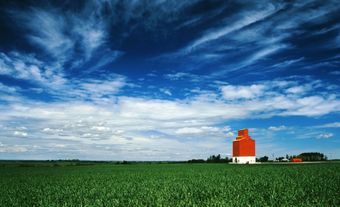Tobacco (Nicotiana tabacum) is an annual herbaceous plant of the nightshade family. In Canada, tobacco growing expanded commercially in the late 19th century.

History
Although Canada's tobacco industry developed largely during the 20th century, tobacco growing goes back to early colonial days, when settlers around the St. Lawrence River adopted the smoking customs of Indigenous peoples. French settlers began by copying the agricultural model set by Indigenous peoples. Some years later, a French colonial ordinance forbade retail sale of tobacco in New France, leaving the settlers without an incentive to improve crop quality or yields. Consequently, they grew only enough for their own use, curing it naturally in the open air. This simple method of preparation produced a unique tobacco, tabac canadien. The French colonists began trading tobacco in 1652, but the French government did not encourage tobacco growing in Canada until 1735, after which the crop was cultivated regularly. Two varieties of tobacco were native, Petit Canadien and Rose Quesnel. In Upper Canada the tobacco-growing industry was founded around Kent and Essex counties by Loyalists who came from the southern United States during the American Revolution and brought tobacco seeds with them.
19th Century
When tobacco growing expanded commercially in the late 19th century, the principal type cultivated in Quebec and Ontario was burley (with some additional varieties of pipe tobacco in Quebec). At this time, Quebec led production: the yield in Canada in 1870-71 was 723,589 kg, of which 181,381 kg were produced in Ontario and 542,208 kg in Quebec. Production in the two provinces expanded rapidly, reaching 7,938 000 kg by 1910, with Quebec still the leader.
20th century
At the start of the 20th century, important changes took place in the industry. During the First World War the popularity of chewing and pipe tobaccos declined and the demand for cigarettes grew rapidly. At the same time, a new curing method, flue curing, produced a type of tobacco (Virginia) better suited for cigarettes. This development revolutionized the Canadian tobacco industry. William T. Gregory and his brother Francis were primarily responsible for developing flue-cured tobacco in Canada. William came to Canada from North Carolina in 1900 to work for the Empire Tobacco Co (then a subsidiary of the American Tobacco Co, later taken over by the Imperial Tobacco Co of Canada). He arrived in Leamington, Ontario, where only burley tobacco was being grown, and decided to plant Virginia tobacco. Francis came to Canada in 1901 to supervise these experiments. The company encouraged the brothers, who hoped to replace expensive US imports with Canadian-grown, flue-cured tobacco.
William chose the Leamington district as the initial growing area because of its desirable soil type and its claim to a longer frost-free period than any other area in Ontario. The results were encouraging, and skilled US growers were brought to Canada to teach farmers growing and curing methods. By 1920, 3.6 million kg of flue-cured tobacco were being produced around Leamington. In 1922 further experimentation with flue-cured tobacco was done in the Lake Erie area, which had large tracts of sandy soil suited for the plant. The first successful crop was grown in 1925, beginning a new era in the history of Canadian tobacco.
With the development of this new growing belt, the industry eventually spread to 12 other areas in the province. Ontario is now the major tobacco producer in Canada. The major growing areas in Quebec are north of Montreal, in Montcalm and Joliette counties. Production of flue-cured tobacco in the province started in 1930 and, by 1933, two curing kilns had been built, one in each county.
Late 20th Century
Today, Canada is considered a major player in the tobacco-growing field, and a supplier of quality tobacco, producing over 69 million kg annually. While most of the crop is sold to Canadian tobacco-products manufacturers, some 16.1 million kg were sold for export, at a value of more than $90 million, in 1995. The major destinations for Canadian tobacco are European Community countries, the United States, Turkey and Hong Kong.
In 1995 the Canadian production of finished tobacco products generated approximately 21, 000 jobs in Canada, of which nearly 11, 000 direct jobs were in the tobacco growing, processing and product manufacturing sectors. Another 10,000 jobs were accounted for by suppliers to those sectors in Canada. Further, more than 26,000 direct jobs in tobacco wholesaling and retailing were supported by domestic sales of legitimate tobacco products in 1995, with an additional 5,400 jobs supplying those two sectors.
In 1995 Canadian tobacco products manufacturers shipped more than 45.5 billion cigarettes to domestic markets, and another 5.9 billion to export and duty-free destinations. Imported sales of cigarettes totaled more than 360 million in 1995. Domestic fine-cut tobacco sales amounted to 3.8 million kg in 1995, while an additional 385 000 kg were shipped to export and duty-free markets. Another 750,000 kg were imported. More than 130 million domestically produced cigars were sold in Canada in 1995, with more than 40 million others imported into Canada. Total domestic consumer expenditure on tobacco products was about $8 billion in 1995, with roughly $5 billion of that collected by federal and provincial governments in taxes. Of the three major manufacturers, one is 100 per cent American owned and two are publicly held companies in Canada.

 Share on Facebook
Share on Facebook Share on X
Share on X Share by Email
Share by Email Share on Google Classroom
Share on Google Classroom




